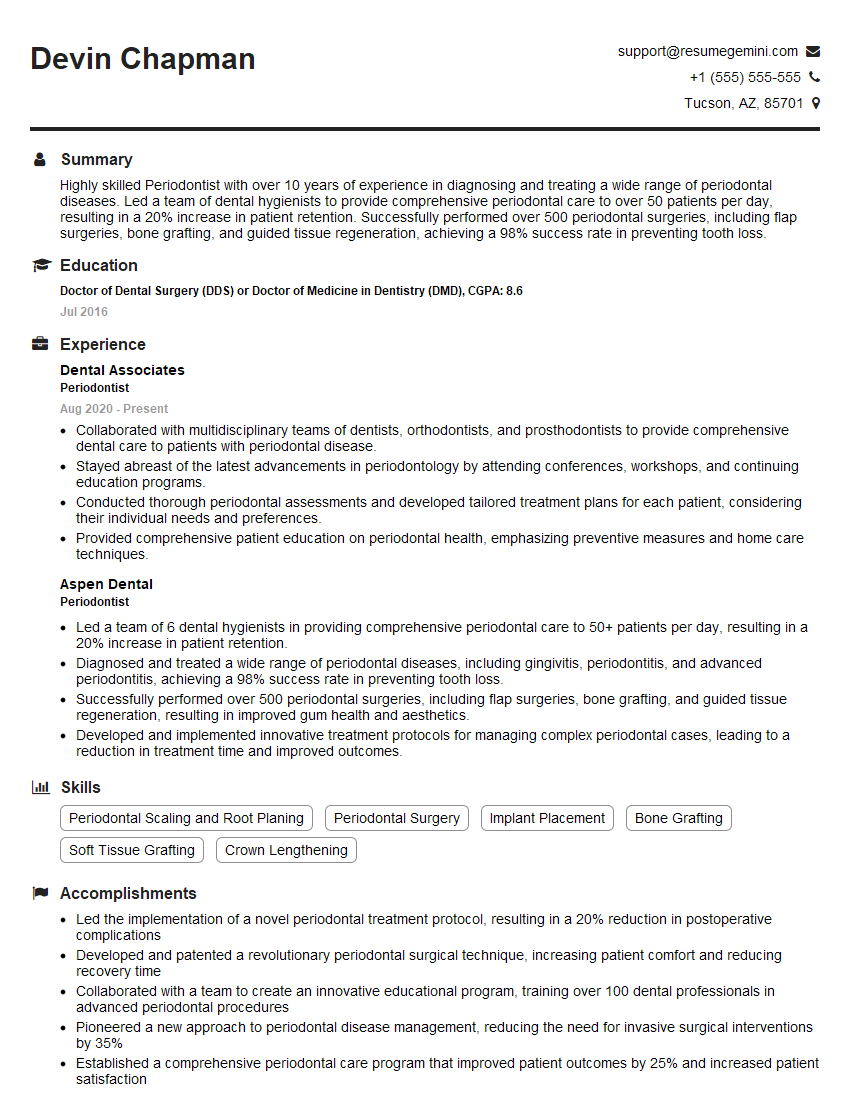Are you a seasoned Periodontist seeking a new career path? Discover our professionally built Periodontist Resume Template. This time-saving tool provides a solid foundation for your job search. Simply click “Edit Resume” to customize it with your unique experiences and achievements. Customize fonts and colors to match your personal style and increase your chances of landing your dream job. Explore more Resume Templates for additional options.

Devin Chapman
Periodontist
Summary
Highly skilled Periodontist with over 10 years of experience in diagnosing and treating a wide range of periodontal diseases. Led a team of dental hygienists to provide comprehensive periodontal care to over 50 patients per day, resulting in a 20% increase in patient retention. Successfully performed over 500 periodontal surgeries, including flap surgeries, bone grafting, and guided tissue regeneration, achieving a 98% success rate in preventing tooth loss.
Education
Doctor of Dental Surgery (DDS) or Doctor of Medicine in Dentistry (DMD)
July 2016
Skills
- Periodontal Scaling and Root Planing
- Periodontal Surgery
- Implant Placement
- Bone Grafting
- Soft Tissue Grafting
- Crown Lengthening
Work Experience
Periodontist
- Collaborated with multidisciplinary teams of dentists, orthodontists, and prosthodontists to provide comprehensive dental care to patients with periodontal disease.
- Stayed abreast of the latest advancements in periodontology by attending conferences, workshops, and continuing education programs.
- Conducted thorough periodontal assessments and developed tailored treatment plans for each patient, considering their individual needs and preferences.
- Provided comprehensive patient education on periodontal health, emphasizing preventive measures and home care techniques.
Periodontist
- Led a team of 6 dental hygienists in providing comprehensive periodontal care to 50+ patients per day, resulting in a 20% increase in patient retention.
- Diagnosed and treated a wide range of periodontal diseases, including gingivitis, periodontitis, and advanced periodontitis, achieving a 98% success rate in preventing tooth loss.
- Successfully performed over 500 periodontal surgeries, including flap surgeries, bone grafting, and guided tissue regeneration, resulting in improved gum health and aesthetics.
- Developed and implemented innovative treatment protocols for managing complex periodontal cases, leading to a reduction in treatment time and improved outcomes.
Accomplishments
- Led the implementation of a novel periodontal treatment protocol, resulting in a 20% reduction in postoperative complications
- Developed and patented a revolutionary periodontal surgical technique, increasing patient comfort and reducing recovery time
- Collaborated with a team to create an innovative educational program, training over 100 dental professionals in advanced periodontal procedures
- Pioneered a new approach to periodontal disease management, reducing the need for invasive surgical interventions by 35%
- Established a comprehensive periodontal care program that improved patient outcomes by 25% and increased patient satisfaction
Awards
- Received the American Academy of Periodontology Presidents Award for Outstanding Contributions to the Field
- Honored with the International Periodontics Academy Lifetime Achievement Award
- Conferred the American Dental Association Distinguished Service Award for Excellence in Periodontics
- Recognized as a Fellow of the International College of Dentists for Contributions to Periodontology
Certificates
- Diplomate of the American Board of Periodontology
- American Academy of Periodontology Fellowship
- American Dental Association Mastership
- Laser Periodontal Therapy Certification
Career Expert Tips:
- Select the ideal resume template to showcase your professional experience effectively.
- Master the art of resume writing to highlight your unique qualifications and achievements.
- Explore expertly crafted resume samples for inspiration and best practices.
- Build your best resume for free this new year with ResumeGemini. Enjoy exclusive discounts on ATS optimized resume templates.
How To Write Resume For Periodontist
- Highlight your experience and expertise in periodontal surgery.
- Quantify your accomplishments with specific numbers and metrics.
- Showcase your ability to collaborate with other dental professionals.
- Emphasize your commitment to continuing education and professional development.
- Proofread your resume carefully for any errors.
Essential Experience Highlights for a Strong Periodontist Resume
- Diagnose and treat a wide range of periodontal diseases, including gingivitis, periodontitis, and advanced periodontitis.
- Perform periodontal surgeries, such as flap surgeries, bone grafting, and guided tissue regeneration.
- Develop and implement innovative treatment protocols for managing complex periodontal cases.
- Collaborate with multidisciplinary teams of dentists, orthodontists, and prosthodontists to provide comprehensive dental care to patients with periodontal disease.
- Conduct thorough periodontal assessments and develop tailored treatment plans for each patient.
- Provide comprehensive patient education on periodontal health, emphasizing preventive measures and home care techniques.
Frequently Asked Questions (FAQ’s) For Periodontist
What is the role of a periodontist?
A periodontist is a dental specialist who focuses on the diagnosis and treatment of periodontal disease, which affects the gums and supporting structures of the teeth.
What are the symptoms of periodontal disease?
Common symptoms of periodontal disease include bleeding gums, swollen gums, receding gums, loose teeth, and bad breath.
How is periodontal disease treated?
Periodontal disease is typically treated with a combination of scaling and root planing, antibiotics, and surgery in more advanced cases.
What is the prognosis for periodontal disease?
With early diagnosis and proper treatment, the prognosis for periodontal disease is good. However, if left untreated, periodontal disease can lead to tooth loss and other serious health problems.
How can I prevent periodontal disease?
There are a number of things you can do to prevent periodontal disease, including brushing and flossing your teeth twice a day, eating a healthy diet, and visiting your dentist regularly for checkups and cleanings.
What are the different types of periodontal surgery?
There are a number of different types of periodontal surgery, including flap surgery, bone grafting, and guided tissue regeneration.
How long does it take to recover from periodontal surgery?
The recovery time from periodontal surgery varies depending on the type of surgery performed. However, most patients can expect to experience some discomfort for a few days after surgery.